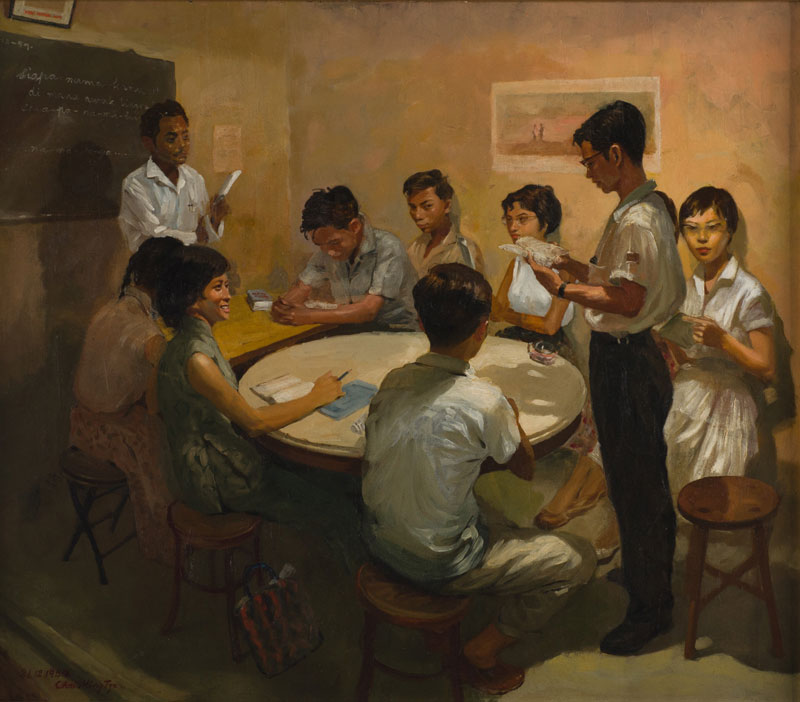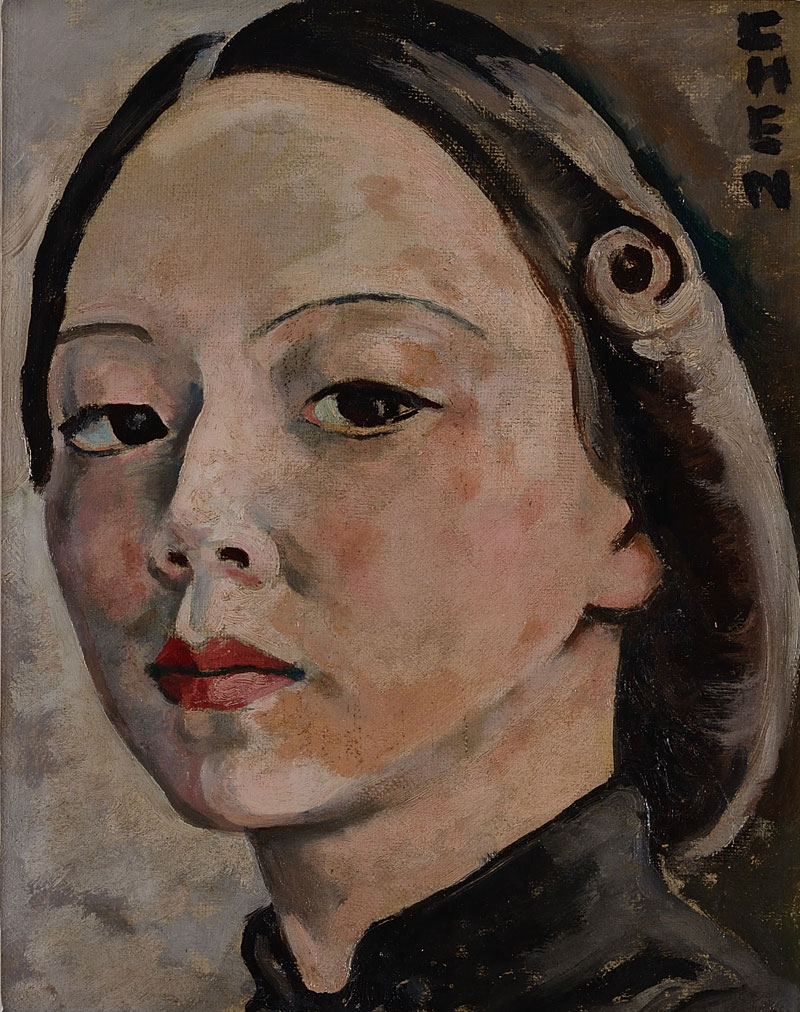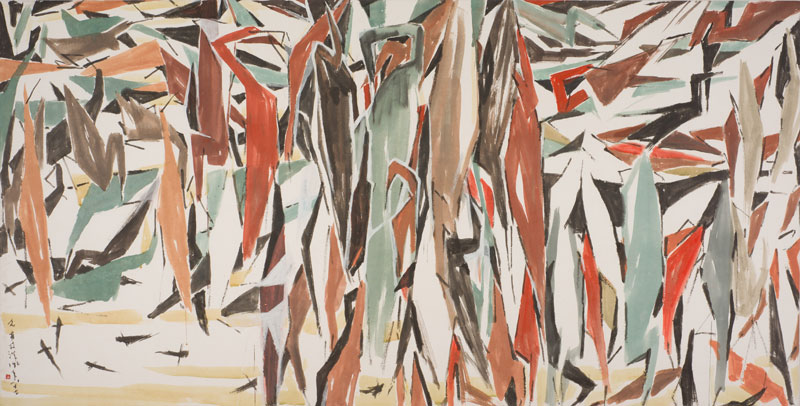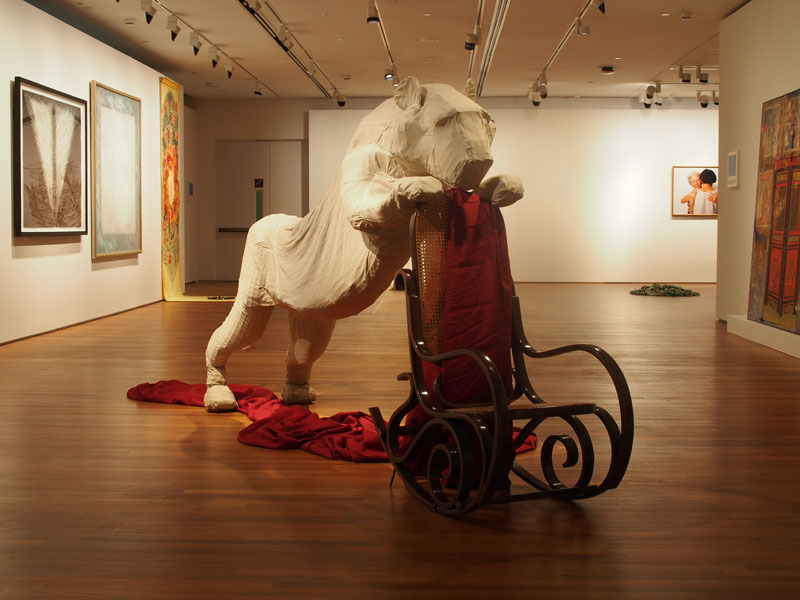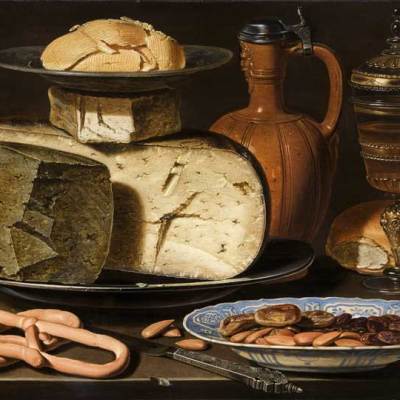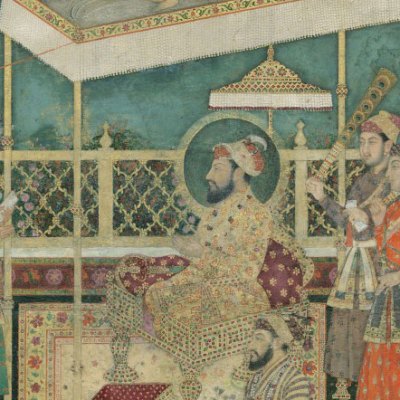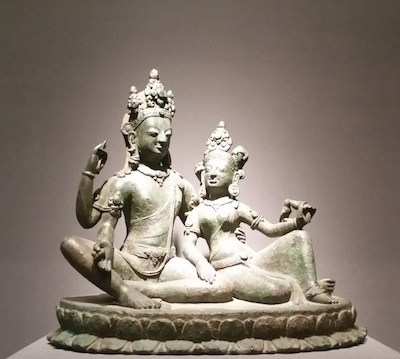‘Would this nation of transients who had come to seek a livelihood under the British Crown one day become a nation with a culture of its own, created somehow out of its own diversity?’ J.G. Farrell, The Singapore Grip (1978)
National Language Class was painted by Chua Mia Tee in 1959, the year that Singapore gained self-governance from Britain. As such, it captures a crucial moment in the country’s history. It depicts a group of Chinese students huddled around a table learning Malay, officially established that same year as Singapore’s national language. Just decipherable on the blackboard is the phrase ‘Siapa Nama Kamu?’ (‘What is your name?’). It’s a question that also forms the title of a permanent exhibition of Singaporean art at the country’s newly inaugurated National Gallery – a 64,000 square metre behemoth dedicated to modern Southeast Asian art. The painting’s exploration of identity resonates beyond the personal in the historical context of Singapore, which last year celebrated its 50th anniversary as an independent nation. The exhibition ‘Siapa Nama Kamu?’ – and indeed, the National Gallery itself – not only ask what Singaporean art is, but also what is Singapore?
Driving into the city from Changi Airport, past the slick government residential blocks that house the majority of Singaporeans, it’s the tree-lined boulevard that captures my attention. Such manicured landscaping is, the taxi driver reminds me, no accident: a result of the government’s ‘green policy’, launched in 1967, which was designed to transform Singapore into a place of lush greenery. Since then, the country has blossomed from a garden city to become widely known as the City in the Garden.
Singapore’s sheen – famously exemplified by its ban on chewing gum – is hard to ignore. It shouts from the top of the Marina Bay Sands complex, a three-towered spaceship that seems to encapsulate modern Singapore. Nearby, glittering skyscrapers announce the city’s status as a corporate and financial hub. For all its strangeness and unreality, Singapore is in many ways a remarkable success story. Since gaining independence in 1965 – having survived British rule, Japanese occupation during the Second World War, and a two-year federation with Malaysia – the country has developed into one of the world’s richest commercial centres. Singapore’s first Prime Minister, Lee Kuan Yew, produced a stable one-party state through a relentless pragmatism driven by the desire for a ‘First World Oasis in a Third World region’. Singapore has little crime and ranks high in terms of life expectancy and personal income, but the image of the country as a controlling nanny state is difficult to shake: no opposition party until 1981; fines for social misconduct; a censored (and often self-censoring) press. The sci-fi novelist William Gibson described Singapore as a ‘Single-party capitalist technocracy’, a ‘tightly-run ship’, and ‘Disneyland with the death penalty’.
Writing in 1993, Gibson saw Singapore as prosperous but bland. Obsessed by economic development and the material welfare of its residents, the government had neglected the country’s cultural development. The late 1980s and early ’90s, however, saw an active change in Singapore’s arts policy – the start of a long-term campaign, enacted with all the efficiency one would expect, to promote Singapore as a global arts centre. The outcome of the 1989 Advisory Council Report on Arts and Culture was the establishment of a significant arts infrastructure, in the form of the National Arts Council and the National Heritage Board. Some S$1billion in arts funding was allocated to the likes of the National Museum of Singapore, the Asian Civilisations Museum, and the Singapore Art Museum (SAM), the latter of which opened in 1996. Yet government efforts to invigorate Singapore’s cultural life have often been criticised (by journalists and academics, among others) for their perceived emphasis on economic imperatives and nation-building rather than art.
In recent years, Singapore’s art scene has changed even more dramatically, with further money poured into museum-building and cultural events. In 2012 the government pledged S$274m to arts and culture, while in 2014 S$65m was allocated to revamping its museums. An artist has represented Singapore at the Venice Biennale since 2001, and the country’s own biennale was inaugurated in 2006. Gillman Barracks, established in 2012 and located on a former military site, houses an international roster of commercial galleries including Hong Kong’s Pearl Lam, Berlin’s Matthias Arndt and Shanghai’s ShanghArt, while Art Stage Singapore has emerged as the leading Southeast Asian contemporary art fair. Increasing the country’s international outlook is central to the Centre for Contemporary Art (CCA), led by German super-curator Ute Meta Bauer, and also the Singapore Tyler Print Institute (STPI). ‘STPI has placed Singapore on the map, especially in making the scene known to the international art community […] and that in turn has contributed to the wider art scene in Singapore,’ director Rita Targui tells me. And, as she also makes clear, it seems the cultural investment has paid off: ‘The art scene here has certainly blossomed in recent years. There is a […] growing acknowledgement of the arts in Singapore as necessary to our growth, preservation and relevance.’
In many ways, the new National Gallery Singapore, a 10-year project with a total cost of S$530m, is the culmination of the government’s rapid efforts to improve the arts, and a potent symbol of the country’s regional and global ambition. ‘If you visit the great capitals of the world – New York, Paris, London, Shanghai, Mumbai – you’ll find that arts and culture are an integral part of these cities,’ said Prime Minister Lee Hsien Loong at the gallery’s opening last November, aligning Singapore with established, or emerging artistic centres. Such cities also have strong historical identities, and it is notable that, despite Singapore’s penchant for building modern, futuristic structures, the National Gallery occupies two of the country’s colonial buildings on the edge of the open field known as the Padang. The former Supreme Court and City Hall, completed in 1939 and 1929 respectively, are not only symbolic of British rule, but also function as sites of national memory: City Hall is where the Japanese surrendered Singapore back to Britain in 1945, and where Lee Kuan Yew declared the country’s self-governance in 1959 and its independence six years later.
The National Gallery Singapore occupies the former colonial buildings of the Supreme Court (left) and City Hall

The City Hall chamber has been carefully preserved by Paris architects Studio Milou, in conjunction with local firm CPG Consultants. They’ve achieved a simple, elegant solution that merges the two buildings but remains faithful to their original features. The glistening filigree and glass roof that sweeps like a veil over the museum’s entrance unites the two buildings and provides a delicate counterpoint to their bold neoclassical facades. In its rush outwards, this roof offers a welcoming gesture. Inside, bridges connect the two buildings, and tree-like steel structures support glass atrium ceilings. These are covered by an aluminium screen roof dappled in different shades of gold, mimicking the look of woven rattan – a filter from Singapore’s abrasive daylight. Among the most important additions is a large basement ticketing concourse, which links the two buildings at their lower levels and aids visitor orientation.
‘These buildings can be intimidating from the exterior but inside we wanted the spaces to be more intimate,’ says Eugene Tan, the gallery’s mild-mannered director. ‘Of course art itself can be quite intimidating for a young nation like Singapore,’ he adds. Indeed, the gallery is vast and even overwhelming in places, though teak wood, limestone and wood veneer bring new warmth to the interiors of the original civic architecture. What’s more, the harmony between old and new emerges, in part, through deliberate emphasis on the differences in architectural languages. ‘Whenever a new floor or wall was added, we made sure it was very clearly distinguishable – using glass balustrades as opposed to parapets for example. It’s important for people not to get the history mixed up,’ says Sushma Goh, the gallery’s project director.
This sensitive approach is clear in the gallery spaces. Two central wings for exhibiting the permanent collection display a diverse range of art in all media. The works span the 19th century to the present, with 400 pieces in each gallery drawn from a 10,000-strong national collection (developed from a seed collection donated by Loke Wan Tho in the 1960s), alongside private and institutional loans. City Hall houses the DBS Singapore Gallery, where the exhibition ‘Siapa Nama Kamu?’ focuses on Singaporean art, and the former Supreme Court – replete with courtrooms, offices, and art-deco details – hosts the UOB Southeast Asia Gallery and its exhibition ‘Between Declarations and Dreams’, which offers a perspective on the art of the region. While the National Gallery is committed to showing the art history of Singapore, much emphasis is placed on its commonalities with neighbouring countries – all of whom share a legacy of colonialism, war, independence, and modernisation. ‘There is an imperative to tell the history of art of the nation. But how we tell that history is something we’ve been thinking long and hard about. It’s connected to the history of the region as well, and is about understanding the links between the different countries within the region,’ Tan tells me.
A regional perspective is not without its complexities. One of the most densely populated and culturally diverse regions, Southeast Asia is made up of 10 countries, grouped roughly south of China and east of India. Of course, the National Gallery Singapore can’t be a national museum for the whole region, as curatorial director Low Sze Wee explains: ‘We don’t feel that a regional perspective can replace a national one – there is a value in both. We hope for a diversity of perspectives.’ For senior curator Lisa Horikawa, ‘The exchange we’ve been having with researchers of the region has been liberating. Putting on a regional exhibition with a regional perspective also helps us to go beyond the connections across national borders.’ For all this, there is a certain power at play here: Singapore is situating itself as the centre of the Southeast Asian art world. Importantly, though, as Tan reminds me, ‘This is the first time there will be a long term and extensive exhibition devoted to the historical development of art in Southeast Asia from a regional perspective.’
Unterbrochene Strassenmessung auf Singapore (Interrupted Road Surveying in Singapore; 1865), Heinrich Leutemann courtesy National Heritage Board
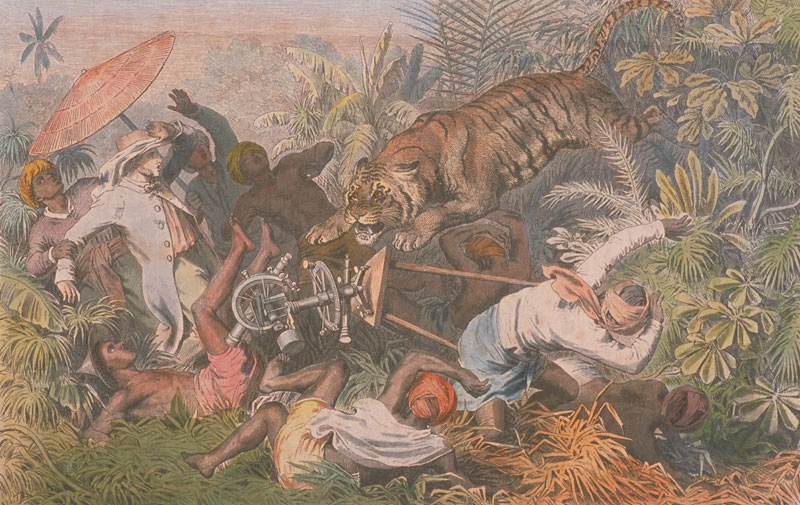
Indeed, such a cohesive public display of Southeast Asian art is a huge achievement; many of these works were scattered in archives and private collections. A former courtroom in the Southeast Asia Gallery is well suited to the archival display of books, maps, and manuscripts. And given their exhibition location, the 19th-century works detailing colonial experiences have an especial resonance here. Heinrich Leutemann’s 1865 wood engraving – the first work displayed in the Singapore Gallery – depicts a tiger jumping from the jungle towards George Drumgoole Coleman, the architect responsible for planning much of early Singapore. In Leutemann’s image, the tiger seems to disrupt the apparently ‘civilising’ efforts of the British Empire. In the first room of the Southeast Asia gallery, Raden Saleh’s Forest Fire (1849), a dramatic representation of wild animals, reveals the inspiration that the Indonesian artist drew from the European Romantic tradition.
By contrast, post-war social-realist artists such as Chua Mia Tee and Lee Boon Wang reject idealism and myth to depict fledgling nations fighting for independence. The impact of the wider region on Singapore artists is found in the Nanyang group of painters – Chen Wen Hsi, Cheong Soo Pieng, Liu Kang, and Chen Chong Swee – whose travels to Bali in 1952 inspired a vibrant style now regarded as Singapore’s first modern art movement. Other works show wider, more cosmopolitan influences at play. Georgette Chen, whose 1946 self-portrait is displayed here, brought influences from the School of Paris to Singapore. In the post-war period, artists such as Hernando R. Ocampo drew on international trends in abstract art, while the later work of Chen Wen Hsi, especially Herons (c. 1991), reveals the cross-cultural influences of both Western art and Chinese ink painting. Elsewhere, protest art speaks out against oppression in Vietnam and the Philippines.
These permanent displays will change every five years, allowing narratives to evolve as new research emerges. ‘I’m constantly surprised by how much we don’t know about our own collection. The permanent galleries, where we have the luxury of five years, are really an opportunity to go into our store rooms and discover new works,’ Low Sze Wee explains. Research and education clearly occupy an important role here. One of the gallery’s most interesting initiatives is its ‘Social Table’, an interactive display that allows visitors to explore the collection. But alongside such technological wizardry, the gallery remains committed to more traditional methods of engagement. ‘All our exhibitions must have a scholarly catalogue,’ Low Sze Wee explains, ‘but we are also looking at wider gaps – we still don’t have a fully fledged art history department in any of our universities.’ Interest in arts education in Singapore has increased, however, with local institutions such as Nanyang Academy of Fine Arts and Lasalle College of the Arts to the fore. Low Sze Wee continues: ‘We’re working closely with the National University of Singapore on establishing a minor in art history for their arts and social science faculty. The idea is that the National Gallery can do more in terms of scholarship.’
One of the questions raised by the National Gallery is where it sits in relation to the Singapore Art Museum. When SAM opened in 1996, it had a broad mission to collect and present modern and contemporary Southeast Asian art. Why, then, does Singapore need the National Gallery? Low Sze Wee explains: ‘It was decided that the Singapore visual arts ecosystem would benefit by having more museums rather than fewer. The decision was to retain SAM and to grow a new one.’ Both institutions share the national collection and focus on the same geographical region, but are responsible for different periods, with SAM now a purely contemporary art space. The two institutions can borrow from each other, but despite all the talk of collaboration, their similar remits also offer the potential for healthy competition in the future.
Also hazy is the extent to which the National Gallery can operate independently from the strictures of the state. The museum is funded primarily by the government, although it does operate as a private company that is responsible for its own budget. ‘We’re somewhere between the UK and US model. We’re trying to think about financial sustainability in the future – to build up endowments as part of our operating costs while still being dependent on the state,’ says Tan. As a public institution, the gallery is accountable for its spending. Does relying on recurrent government support affect the museum’s activities? ‘It hasn’t yet! Up until now the history of Singaporean art has been told in a certain way. In our retelling we open up new areas that were perhaps more sensitive in the past. We were surprised at how we are now in a position to be more transparent,’ Tan explains. Censorship, however, has long affected the arts in Singapore, particularly in the field of the performing arts. While the social-realist woodcuts made by Singaporean artists in the 1950s and the contemporary works by Tang Da Wu and Amanda Heng suggest a level of critical engagement with state policies, it remains to be seen just how much freedom the gallery will have.
I ask Tan who the gallery is for: ‘First and foremost for the people who live in Singapore and who consider Singapore to be an important part of the region.’ But who are the people who make up Singapore? With four national languages and a population composed of around 74 per cent Chinese, 13 per cent Malay, and 9 per cent Indian, Singapore confuses any traditional notions of nationhood. ‘Because the city-state cannot boast a long history and is inhabited by a multitude of different ethnicities, the Singaporean nation (if it actually exists) has to be considered a distinctly modern and decidedly constructed phenomenon,’ notes academic Stephan Ortmann. Of course, to some extent national identity is always constructed, and in Singapore the arts are playing a crucial role in nation-building. Low Sze Wee agrees that the National Gallery is for Singaporeans, but adds: ‘The government also see us as a symbol for Singapore externally, in terms of how we present ourselves internationally.’ The National Gallery is another step towards Singapore’s reinvention.
From the March issue of Apollo: preview and subscribe here.
